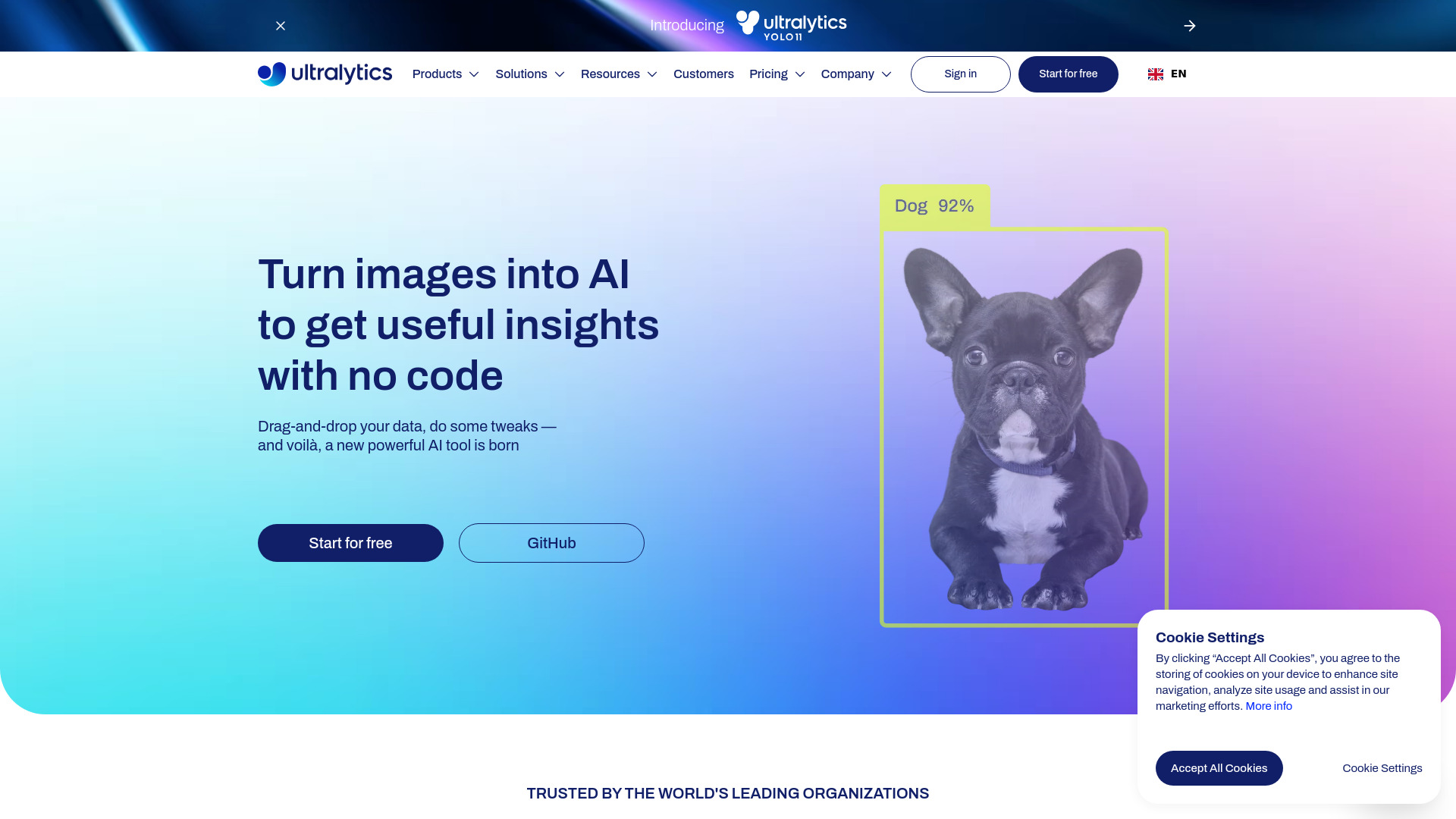- Home
- AI Image Recognition
- Ultralytics

Ultralytics
Open Website-
Tool Introduction:Build, train, and deploy vision AI - no code on HUB, powered by YOLO.
-
Inclusion Date:Oct 21, 2025
-
Social Media & Email:
Tool Information
What is Ultralytics AI
Ultralytics AI provides production-ready computer vision tools that make it easy to build, train, and deploy models. Its flagship platform, Ultralytics HUB, offers a no-code workflow for dataset management, labeling, training, evaluation, and one-click deployment. Complementing HUB, Ultralytics YOLO (e.g., YOLOv8) delivers state-of-the-art image classification, object detection, and instance segmentation with fast inference and high accuracy. Together, they streamline the path from raw images to reliable edge and cloud inference for teams in any industry.
Ultralytics AI Main Features
- No-code training in Ultralytics HUB: Create projects, manage datasets, and launch training without writing code.
- State-of-the-art YOLO models: High-accuracy object detection, instance segmentation, and classification with YOLOv8.
- Data labeling and management: Built-in annotation tools, versioning, and dataset splits for reproducible experiments.
- Automated training and tuning: Sensible defaults, hyperparameter controls, and experiment tracking to improve mAP and latency.
- Flexible deployment: Export to ONNX, TensorRT, CoreML, and more for edge devices or cloud services.
- Real-time inference: Optimized runtimes for GPUs and CPUs enable low-latency streaming use cases.
- Monitoring and iteration: Evaluate precision/recall, confusion matrices, and segment masks to refine models.
- API/SDK integration: Integrate models into applications with REST endpoints and Python workflows.
- Scalable MLOps: Team collaboration, experiment history, and deployment lifecycle management.
Ultralytics AI Suitable For
Ultralytics AI suits data scientists, ML engineers, and software developers who need fast, accurate computer vision. It also helps product teams, startups, and enterprises ship vision features without heavy ML ops overhead. Educators and researchers benefit from reproducible pipelines and strong baselines, while operations teams can power quality inspection, safety monitoring, and analytics at the edge.
Ultralytics AI Usage Steps
- Sign up for Ultralytics HUB and create a new project.
- Import or label your dataset (images/videos) and define classes.
- Select a task type: classification, object detection, or instance segmentation.
- Choose a YOLOv8 model variant and set training parameters (epochs, image size, augmentation).
- Launch training; track metrics such as loss, precision, recall, and mAP.
- Review results, analyze errors, and iterate on data or hyperparameters.
- Export the model (ONNX/TensorRT/etc.) or deploy via API for cloud/edge inference.
- Monitor performance in production and continuously improve with updated datasets.
Ultralytics AI Industry Use Cases
Retail teams can detect products, track shelf availability, and prevent loss with real-time object detection. Manufacturers use segmentation to spot defects on assembly lines and automate quality control. Logistics providers detect parcels, read barcodes, and measure throughput. Smart cities analyze traffic flows and safety events, while agriculture teams monitor crops, weeds, and livestock using edge devices in the field.
Ultralytics AI Pricing Model
Ultralytics YOLO is open source (e.g., YOLOv8 under AGPL-3.0) and free to use under its license. Ultralytics also offers commercial licenses and enterprise support for organizations needing proprietary usage or compliance assurances. Ultralytics HUB provides managed training and deployment with paid plans; consult the official pricing page for current tiers and any available trials.
Ultralytics AI Pros and Cons
Pros:
- End-to-end no-code to pro-code workflow from data to deployment.
- State-of-the-art YOLO models with strong accuracy and speed.
- Rich export options for edge and cloud (ONNX, TensorRT, CoreML, etc.).
- Robust evaluation tools and experiment tracking for reproducibility.
- Active ecosystem, documentation, and community support.
Cons:
- Focused on computer vision; not a fit for NLP or non-vision tasks.
- Quality labeled data is essential; dataset creation can be time-consuming.
- Training at scale may require significant GPU resources and cost.
- Open-source license obligations may require a commercial license for some use cases.
Ultralytics AI FAQs
-
Question 1: What tasks does Ultralytics YOLO support?
It supports image classification, object detection, and instance segmentation with YOLOv8 and related models.
-
Question 2: Do I need to code to use Ultralytics HUB?
No. HUB provides a no-code interface for dataset management, training, evaluation, and deployment.
-
Question 3: Can I deploy models to edge devices?
Yes. You can export to formats like ONNX or TensorRT and run optimized inference on GPUs, Jetson, or CPU.
-
Question 4: How do I integrate a trained model into my app?
Use HUB’s deployment endpoints or export the model and integrate via Python/REST with your preferred runtime.
-
Question 5: Is there a commercial license available?
Ultralytics offers commercial licenses and enterprise support; review official terms to choose the right option.






